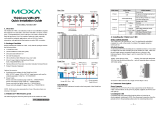
Table of Contents
Chapter 1 Introduction..................................................................................................1-1
Overview.................................................................................................................................. 1-2
Package Checklist .................................................................................................................... 1-2
Product Features ...................................................................................................................... 1-3
Product Hardware Specifications............................................................................................. 1-3
Hardware Block Diagram ........................................................................................................ 1-5
ThinkCore W315 .......................................................................................................... 1-5
ThinkCore W325 .......................................................................................................... 1-6
ThinkCore W345 .......................................................................................................... 1-6
Chapter 2 Hardware Introduction.................................................................................2-1
Appearance .............................................................................................................................. 2-2
ThinkCore W315 .......................................................................................................... 2-2
ThinkCore W325 .......................................................................................................... 2-2
ThinkCore W345 .......................................................................................................... 2-3
Dimensions .............................................................................................................................. 2-4
ThinkCore W315 .......................................................................................................... 2-4
ThinkCore W325 .......................................................................................................... 2-4
ThinkCore W345 .......................................................................................................... 2-5
LED Indicators......................................................................................................................... 2-6
Reset Button............................................................................................................................. 2-6
Real Time Clock ...................................................................................................................... 2-7
Chapter 3 Hardware Connection Description .............................................................3-1
Installing the W315/W325/W345 ............................................................................................ 3-2
Wiring Requirements ............................................................................................................... 3-3
Connecting the Power................................................................................................... 3-3
Grounding the Unit....................................................................................................... 3-3
Connecting Data Transmission Cables .................................................................................... 3-4
Connecting to the Network........................................................................................... 3-4
Connecting to a Serial Device ...................................................................................... 3-5
Connecting to the Serial Console Port.......................................................................... 3-5
Connecting an Antenna................................................................................................. 3-5
Installing a SIM Card and SD Card ......................................................................................... 3-5
Installing a SIM Card ................................................................................................... 3-5
Installing an SD Card for Storage Expansion............................................................... 3-7
USB (W345 only) .................................................................................................................... 3-8
Relay Output (W345 only)....................................................................................................... 3-8
Appendix A FCC Warning Statement.............................................................................B-1
Appendix B Service Information.....................................................................................B-1
MOXA Internet Services..........................................................................................................B-2
Problem Report Form ..............................................................................................................B-3
Product Return Procedure........................................................................................................B-4























